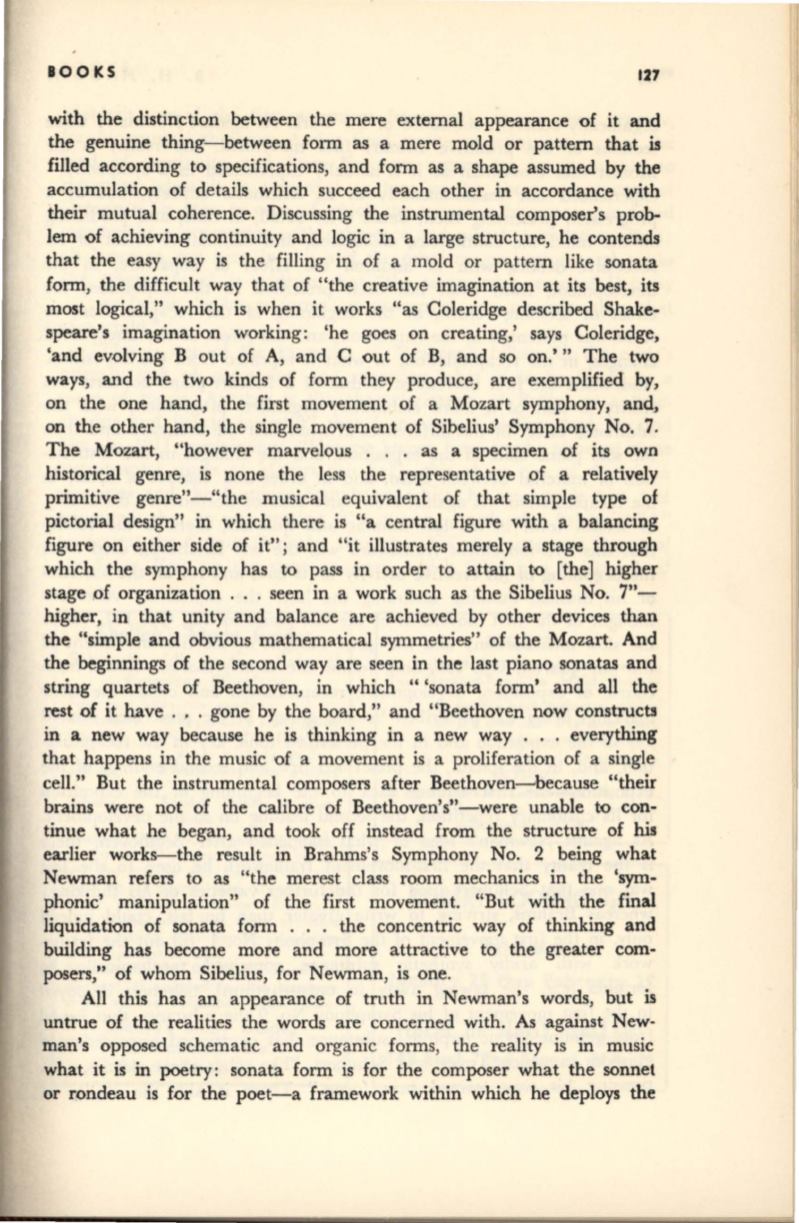
lOOKS
127
with the distinction between the mere external appearance of it and
the genuine thing-between form as a mere mold or pattern that
is
filled according to specifications, and form as a shape assumed by the
accumulation of details which succeed each other in accordance with
their mutual coherence. Discussing the instrumental composer's prob–
lem of achieving continuity and logic in a large structure, he contends
that the easy way is the filling in of a mold or pattern like sonata
form, the difficult way that of "the creative imagination at its best, its
most logical," which is when it works "as Coleridge described Shake–
speare's imagination working : 'he goes on creating,' says Coleridge,
'and evolving B out of A, and C out of B, and so on.'" The two
ways, and the two kinds of form they produce, are exemplified by,
on the one hand, the first movement of a Mozart symphony, and,
on the other hand, the single movement of Sibelius' Symphony No.7.
The Mozart, "however marvelous . . . as a specimen of its own
historical genre, is none the less the representative of a relatively
primitive genre"-"the musical equivalent of that simple type of
pictorial design" in which there is "a central figure with a balancing
figure on either side of it"; and "it illustrates merely a stage through
which the symphony has
to
pass in order to attain to [the] higher
stage of organization ... seen in a work such as the Sibelius No. 7"–
higher, in that unity and balance are achieved by other devices
than
the "simple and obvious mathematical symmetries" of the Mozart. And
the beginnings of the second way are seen in the last piano sonatas and
string quartets of Beethoven, in which "'sonata form' and all the
rest of it have. , . gone by the board," and "Beethoven now constructs
in a new way because he is thinking in a new way . . . everything
that happens in the music of a movement is a proliferation of a single
cell." But the instrumental composers after Beethoven---'because "their
brains were not of the calibre of Beethoven's"-were unable to con–
tinue what he began, and took off instead from the structure of
his
earlier works-the result in Brahms's Symphony No. 2 being what
Newman refers to as "the merest class room mechanics in the 'sym–
phonic' manipulation" of the first movement. "But with the final
liquidation of sonata form . . . the concentric way of thinking and
building has become more and more attractive to the greater com–
posers," of whom Sibelius, for Newman, is one.
All this has an appearance of truth in Newman's words, but is
untrue of the realities the words are concerned with. As against New–
man's opposed schematic and organic forms, the reality is in music
what it is in poetry: sonata form is for the composer what the sonnet
or rondeau is for the poet-a framework within which he deploys the


